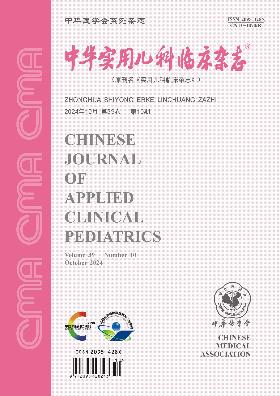静息状态功能磁共振成像研究伴有中央颞棘波的儿童良性癫痫脑功能改变
Q4 Medicine
引用次数: 1
摘要
目的应用基于静息状态脑功能成像的ReHo算法,分析伴有中枢颞棘波的良性癫痫患儿的脑功能波动,探讨脑功能的联系和联系模式的变化,以发现早期BECTS患儿认知功能的损害。方法前瞻性和简单随机选择2015年1月至2017年12月入住深圳儿童医院的20名BECTS儿童和20名健康对照儿童,在静息状态下进行基本信息收集和功能磁共振成像(fMRI)检测。结果s ReHo值在默认模式网络(DMN)区域、楔前叶(体素=422,t=-5.0856)、楔状肌(体素=85,t=-4.2403)、角回(体素=191,t=-4.6812)、扣带皮层(体素=313,t=-5.2382)、中央前回(体元=12,t=-3.4827)和补充运动区(体素=1 356,t-6.5962)中出现显著降低。ReHo在双侧小脑(体素=71,t=5.6582)、右颞上回(体素=24,t=5.18400)、岛盖(体素=337,t=6.8149)、左顶叶(体素=12,t=4.3787)和顶叶下小叶(体素=1 1,t=3.4337)中显著增加。结论BECTS患儿DMN、Wernicke和角回功能明显受损可能是认知功能障碍的机制之一。岛上盖和中央沟附近的感觉运动区和皮层脑功能增强导致癫痫发作,具有典型的临床症状。fMRI对评估BECTS儿童的脑功能具有很高的特异性和敏感性,可以早期检测此类癫痫儿童的认知功能损害。关键词:儿童颞叶中枢棘波的良性癫痫;功能磁共振成像;区域同质性;大脑功能本文章由计算机程序翻译,如有差异,请以英文原文为准。
A resting-state functional magnetic resonance imaging study of altered brain function of benign epilepsy in children with central-temporal spikes
Objective
To analyze the brain functional fluctuation of benign epilepsy in children with central-temporal spikes(BECTS) by using ReHo algorithm based on the resting-state brain functional imaging, and to explore the connection of the brain function and changes of the connection pattern, so as to find the damage of the cognitive function of BECTS children in the early stage.
Method
s Perspectiveness and simple random selection of 20 BECTS children and 20 healthy control children admitted to Shenzhen Children′s Hospital from January 2015 to December 2017 were conducted for basic information collection and functional magnetic resonance imaging (fMRI) testing in a resting-state.
Result
s Significantly lower ReHo value appeared in the default mode network (DMN) area, and the precuneus (voxel=422, t=-5.085 6), cuneus (voxel=85, t=-4.240 3), angular gyrus (voxel=191, t=-4.681 2), cingulate cortex (voxel=313, t=-5.238 2), anterior central gyrus (voxel=12, t=-3.482 7), and supplementary motor area (voxel=1 356, t-6.596 2). The significantly increased ReHo was found in the bilateral cerebellum (voxel=71, t=5.658 2), right superior temporal gyrus (voxel=24, t= 5.184 0), operculum insulae (voxel=337, t=6.814 9), left parietal lobe (voxel=12, t=4.378 7), and inferior parietal lobule (voxel=11, t=3.433 7).
Conclusions
Significant impairment of DMN, Wernicke and angular gyrus functions in BECTS children may be one of the mechanisms of cognitive dysfunction.Enhanced sensorimotor area and cortical brain functions near the operculum insulae and central sulcus lead to seizures with typical clinical symptoms.fMRI has a high specificity and sensitivity for evaluating the brain function of children with BECTS, and it can detect the impairment of cognitive function in children with this type of epilepsy at an early stage.
Key words:
Benign epilepsy in children with central-temporal spikes; Functional magnetic resonance imaging; Regional homogeneity; Brain function
求助全文
通过发布文献求助,成功后即可免费获取论文全文。
去求助
来源期刊

中华实用儿科临床杂志
Medicine-Pediatrics, Perinatology and Child Health
CiteScore
0.60
自引率
0.00%
发文量
14243
期刊介绍:
Chinese Journal of Applied Clinical Pediatrics ( semi-monthly ) is a core journal of paediatrics under the supervision of China Association for Science and Technology, sponsored by Chinese Medical Association and undertaken by Xinxiang Medical College. Founded in 1986, it is openly circulated both at home and abroad. The journal has several columns, such as Expert Forum, Experimental Research and Paediatric Surgery, which are mainly for paediatric medical workers and medical researchers in hospitals. Its purpose is to reflect the new theories and technologies in paediatric medicine and scientific research at home and abroad, and to promote academic exchanges.
Chinese Journal of Applied Clinical Pediatrics is a source journal of China Science Citation Database (CSCD), a core journal of Peking University, a source journal of Chinese science and technology paper statistics (China Science and Technology Core Journals), a core academic journal of RCCSE, a high-quality scientific and technical journal of China, a high-quality scientific and technical journal of China Association for Science and Technology, and a high-quality scientific and technical journal of China Biomedical Science and Technology Association. We have been published in China Biomedical Literature Database (SinoMed), China Knowledge Network, Wanfang Data Knowledge Service Platform, China Academic Journal Abstracts, Scopus Database, Chemical Abstracts (USA), Japan Science and Technology Agency (JSTA) Database, Copernicus Abstracts (Poland), Abstracts of the Centre for Agricultural and Biological Sciences (CABS) of the United Kingdom, Cambridge Scientific Abstracts ProQuest Database, WHO Medical Journal of the Western Pacific Region (WMPR), and WHO Medical Journal of the Western Pacific Region (WMPR) of the United States. We have been included in dozens of authoritative databases at home and abroad, such as WHO Western Pacific Region Index of Medicine (WPRIM), Ullrich's Guide to Periodicals, and so on.
 求助内容:
求助内容: 应助结果提醒方式:
应助结果提醒方式:


